Top 15 Tips to Make Meetings More Accessible for Everyone
Creating accessible meetings is crucial for ensuring equal participation and inclusion for all participants. Toplist has compiled a list of tips to make ... read more...meetings more accessible for everyone. You can check it out!
-
One of the most crucial steps towards making meetings more accessible is fostering a culture where individuals feel empowered to speak up and express their needs. While it may not be possible to cater to every individual's accessibility requirements at all times, creating a safe and inclusive environment where participants can voice their concerns is invaluable. By establishing meetings as spaces where individuals can comfortably request necessary accommodations, you can make timely adjustments and provide accessibility to everyone as needed.
Encouraging open communication allows participants to actively engage and ask for what they need during meetings. For example, if someone is having difficulty seeing the screen-share, they should feel comfortable speaking up and requesting the presenter to zoom in. Similarly, if a participant finds certain elements in the video distracting or problematic, such as a ceiling fan causing visual disturbances, they should be able to express their concerns and ask for adjustments, such as changing the camera angle or blurring the background.
By fostering a culture of speaking up, you create an environment where everyone is better positioned to succeed. It promotes inclusivity, as participants can openly express their accessibility requirements, enabling the necessary adjustments to be made promptly. This approach not only enhances the accessibility of meetings but also cultivates a sense of respect, understanding, and collaboration among all participants.
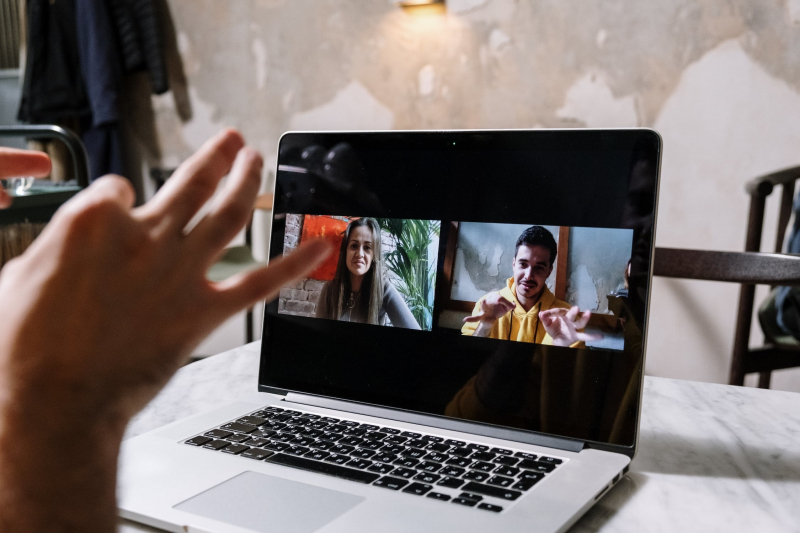
Photo by Anna Shvets via pexels.com 
Photo by cottonbro studio via pexels.com -
To ensure accessibility in meetings, it is essential to provide a clear agenda and any relevant materials well in advance. Having an agenda allows participants to understand the purpose and topics of discussion for the meeting. For recurring meetings, incorporating the agenda into the meeting name or description can provide clarity and expectation. By sharing the agenda ahead of time, participants can adequately prepare and make any necessary accommodations to actively engage in the meeting.
Additionally, providing attendees with copies of materials, such as presentations or documents, prior to the meeting or at the start of the meeting itself, promotes accessibility. Sharing materials in advance allows individuals with disabilities to use assistive technologies, such as screen readers, to access the content effectively. They can zoom in or adjust the format according to their needs, follow along at their own pace, take notes on a local copy, and avoid distractions caused by real-time presentations or technological glitches.
By sharing agendas and materials beforehand, you create a more inclusive environment where all participants have the opportunity to review and engage with the content in a manner that suits their accessibility preferences. This proactive approach empowers individuals with disabilities to fully participate and contribute to the meeting discussions, ensuring that everyone can actively engage and benefit from the meeting.

Photo by Anete Lusina via pexels.com 
Photo by Sora Shimazaki via pexels.com -
Another important practice to enhance accessibility in meetings is to add alt text to images in presentations. Alt text provides a concise description of the image content, enabling individuals who are unable to see the image, either due to disabilities or technical issues, to understand its context. When preparing meeting materials, including presentations, ensure that all important images have corresponding alt text.
When writing alt text, aim to provide a brief summary of the image's key information or message. For example, if you include a financial chart, the alt text should summarize the main insights, such as "Chart showing 50% growth from January to June 2024." This allows individuals relying on screen readers or other assistive technologies to access the visual information and participate in the discussion effectively.
In some meeting software, it may not be possible to add alt text directly to images, especially if they are shared via chat or other real-time features. In such cases, there are alternative approaches to ensure accessibility. The presenter can verbally describe the image briefly if it is crucial to the meeting's content. Alternatively, another participant can type a short description into the chat, ensuring that the information is conveyed to all participants. For example, someone can write "Alt text: a room on fire and a dog sitting in a chair saying, 'This is fine.'"
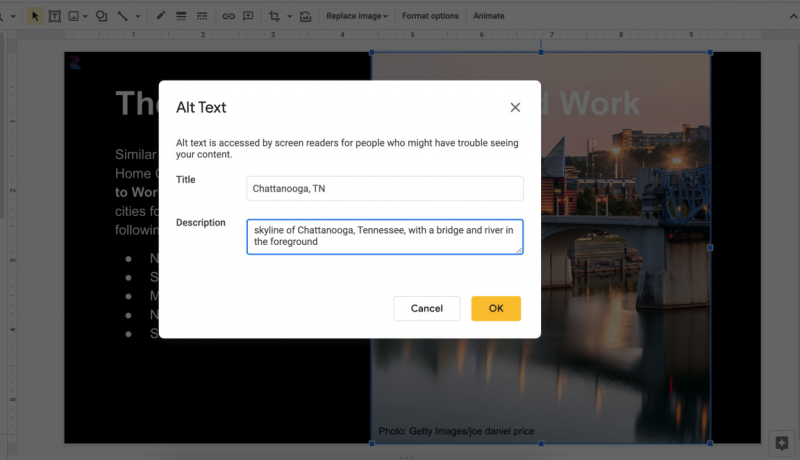
Credit: PCMag 
Photo by Startup Stock Photos via pexels.com -
Incorporating asynchronous elements into meetings can greatly enhance accessibility and productivity. By sending meeting materials, such as slides or documents, ahead of time, you create an opportunity for part of the meeting to be conducted in an asynchronous manner. This means that participants have the chance to review and process the information at their own pace before engaging in real-time discussions.
Introducing an asynchronous component to meetings has several benefits. First, it minimizes the amount of time spent in meetings, as participants have already familiarized themselves with the materials. This allows for more focused and efficient discussions during the live portion of the meeting. Second, it provides individuals with the opportunity to process information, reflect, and formulate their thoughts before engaging in group discussions. This benefits participants who may need more time to comprehend the content or prefer to consider their ideas before sharing them.
Moreover, an asynchronous approach benefits individuals who may face specific challenges in real-time interactions. For example, participants who are not native speakers of the meeting language can review the materials in advance, ensuring better comprehension and facilitating their active participation. Similarly, individuals with speech impediments or who are introverted may find it helpful to have time to prepare and organize their thoughts before engaging in live discussions.

Photo by Vanessa Garcia Photos via pexels.com 
Photo by Vanessa Garcia Photos via pexels.com -
Recording important meetings, large meetings, and webinars is a valuable practice for enhancing accessibility and enabling flexibility for participants. By recording the call and making the video available afterward, you extend accessibility to individuals who were unable to attend the meeting in real time.
The availability of a recorded video allows participants to review the meeting content at their convenience. This is particularly beneficial for those who may have scheduling conflicts or time zone differences that prevent them from attending the live session. By providing access to the recorded video, you ensure that important information and discussions are not limited to those present during the meeting.
Moreover, the recorded video offers several advantages to participants. It enables them to rewatch specific segments of the meeting, ensuring better understanding and retention of crucial information. Participants can also take more detailed notes, clarify any points they may have missed or misunderstood, and engage in deeper reflection on the meeting content.

Photo by EKATERINA BOLOVTSOVA Photos via pexels.com 
Photo by Canva Studio Photos via pexels.com -
Enabling closed captioning during meetings is a crucial step in promoting accessibility and ensuring that individuals with hearing impairments can fully participate and engage in the discussions. Many popular video conferencing platforms, such as Zoom Meetings, Google Meet, and Microsoft Teams, offer automated machine-generated closed captioning features.
In Microsoft Teams, the feature is called Live Captions, and it automatically generates captions during the meeting. Participants can also choose to have the captions translated into various languages, making it more inclusive for multilingual attendees. Google Meet also provides similar functionality, allowing for transcription and translation of captions across different languages.
While automated captions provide a level of accessibility, it's important to note that they may not always be completely accurate. Recognizing this limitation, Microsoft Teams now offers an option called CART captions. CART stands for Communication Access Realtime Translation, and it allows you to invite a professional stenographer to transcribe the meeting in real-time, providing more accurate closed captioning for participants. It's worth noting that the CART captions option requires you to arrange and provide your own stenographer for the meeting.
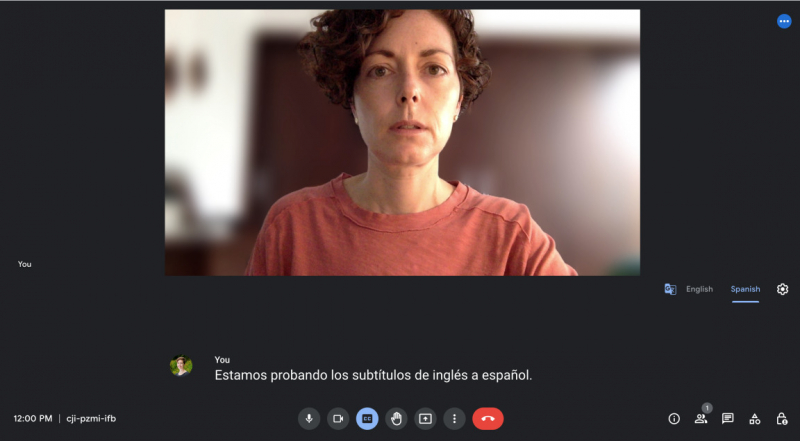
Credit: PCMag 
Photo by Christina Morillo Photos via pexels.com -
You raise an important point about making accessibility features readily available and easily accessible to all meeting participants. By default, software platforms should prioritize accessibility and ensure that necessary features are enabled by default, making them opt-out rather than opt-in.
As technology evolves, it's crucial for software providers to prioritize inclusivity and consider accessibility as a fundamental aspect of their offerings. This includes making accessibility features prominent, intuitive, and enabled by default, so that all users can benefit from them without the need for individual configuration or activation.
By adopting an opt-out approach, accessibility features are automatically available to all meeting participants, facilitating equal access and participation. This eliminates the burden on individuals with disabilities to seek out and activate these features themselves, ensuring that accessibility is seamlessly integrated into the meeting experience.
It is essential for software developers and providers to take responsibility for creating accessible platforms and interfaces. They should invest in user-friendly designs that prioritize accessibility, educate users about the features and their benefits, and make accessibility options clearly visible and straightforward to enable.

Photo via istockphoto.com 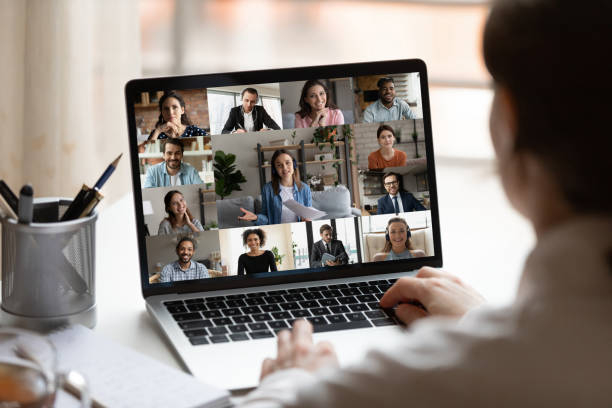
Photo via istockphoto.com -
Reviewing best practices for creating and presenting slideshows is indeed essential to improve accessibility and ensure that your meeting materials are effectively communicated. Here are some key best practices to consider:
Set the font size larger than you might typically use. For in-person meetings, aim for around 40pt, and for virtual meetings, use at least 24pt. Larger font sizes make the text more readable, especially for participants who may have visual impairments or are viewing the slides on smaller screens.
Ensure that your slides are uncluttered and visually clean. Use ample white space, avoid excessive graphics or distracting backgrounds, and maintain a consistent and easy-to-follow layout throughout the presentation. This helps participants focus on the content without unnecessary distractions.
When referencing important products, places, or people, always provide their full written names, including any relevant titles or designations. This helps prevent confusion and ensures that all participants have the necessary information to understand the references. Avoid relying solely on pronouns or informal names that may not be universally recognized.
By adhering to these best practices, you can create slideshows that are more accessible, visually appealing, and effective in conveying your message. It demonstrates your commitment to inclusivity and ensures that all meeting participants can engage with your materials regardless of their accessibility needs.

Photo via istockphoto.com 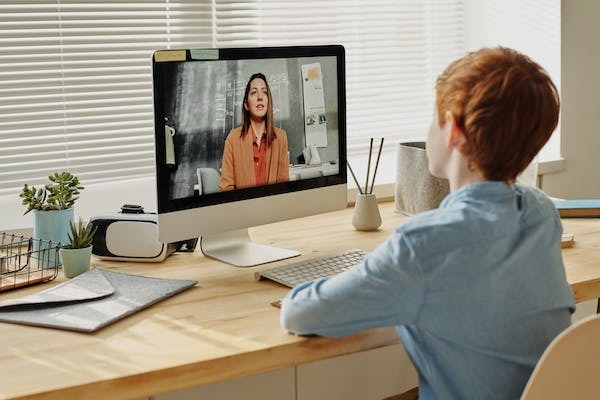
Photo by Julia M Cameron via pexels.com -
When presenting during a meeting, it's beneficial to enable your video and ensure that your face is centered on the screen, taking up the majority of the frame. This allows participants to see your facial expressions, read your lips as you speak, and better understand your message.
If you're using sign language during your presentation, it's important to adjust the camera position accordingly. Back away from the camera enough to ensure that your signing, including your face and torso, is visible to participants. This allows sign language users to fully engage with your presentation.
Regarding other meeting participants, whether they enable their cameras is typically a personal choice. While presenters and meeting hosts may find it useful to see the audience's faces for feedback and engagement, it should not be mandatory for participants to have their cameras on. Some individuals may have privacy concerns, limited bandwidth, or other reasons for not enabling their cameras. It's important to respect individual preferences and ensure that participation is accessible and comfortable for all attendees.
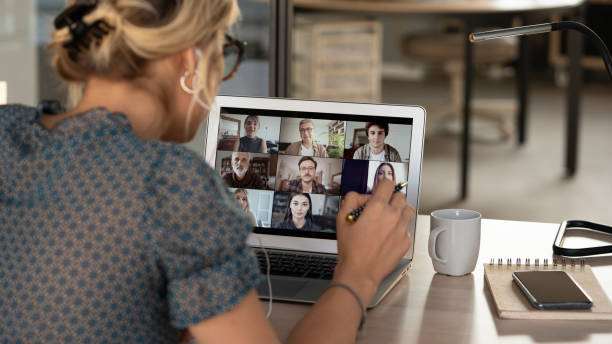
Photo via istockphoto.com 
Photo via istockphoto.com -
Speaking clearly, slowing down, and repeating important information are indeed essential practices to ensure effective communication during meetings, particularly in virtual settings where technological issues can arise.
Focus on articulating your words clearly to ensure that your message is easily understood by all participants. Avoid mumbling or speaking too softly, as it can make it challenging for others to hear and comprehend what you are saying. Speaking clearly enhances overall communication and makes it easier for participants to engage with the discussion.
Remind yourself to pace your speech and avoid rushing through your words. Speaking too quickly can make it difficult for participants to keep up with the content and may lead to misunderstandings. By slowing down your speech, you allow others to process the information more effectively and follow along with the discussion.
It's important to reiterate crucial details or key points during a meeting. Repetition helps to reinforce the information and ensures that participants who may have missed it the first time have an opportunity to catch up. By repeating important information, you assist in clarifying and reinforcing the essential aspects of the discussion.

Photo via istockphoto.com 
Photo via istockphoto.com -
Using headphones and a microphone is not only a standard tip for improving video calls but also an important consideration for accessibility. When participating in video calls, wearing headphones helps eliminate the chance of feedback, creating a more seamless and clear audio experience for both you and other participants. Additionally, using a microphone, whether it's built into a headset or an inexpensive set of headphones with an inline mic, makes it easier for others to hear your voice, ensuring effective communication.
Even when using Bluetooth devices, it's generally acceptable for video calls. However, it's worth noting that over time, as Bluetooth devices age, they may start to degrade and produce static or garbled sounds for other meeting participants. Therefore, it's a good practice to occasionally ask for a thumbs-up from others to ensure that everyone can hear you clearly.
By utilizing headphones and a microphone during video calls, you can enhance the audio quality, minimize feedback issues, and improve accessibility for all participants involved.

Photo by Antoni Shkraba via pexels.com 
Photo by Karolina Grabowska via pexels.com -
It's important to consider the visual environment during video calls, as a cluttered or chaotic background can be distracting and make it difficult for participants to focus. To create a more professional and inclusive setting, you have a couple of options.
First, you can ensure that you have an uncluttered and neutral space behind you. This means organizing your surroundings and removing any unnecessary items or visual distractions. A clean and simple background helps keep the focus on you and your message.
Alternatively, many video conferencing software platforms offer features that allow you to blur or replace your background. These filters can help create a more polished and distraction-free visual environment. By using these settings, you can minimize potential visual disruptions, such as flashing lights, moving objects, or busy patterns, which can be particularly harmful or distracting for people with disabilities.
Whether you choose to create a neutral background or utilize background filters, the goal is to ensure a visually comfortable and inclusive experience for all participants in the video call.

Photo by Karolina Grabowska via pexels.com 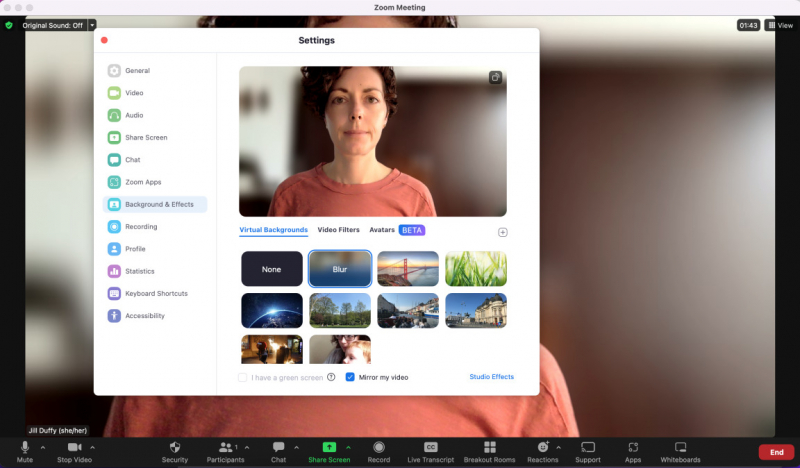
Credit: PCMag -
When you are a passive participant in a meeting, it is generally considered professional and beneficial for accessibility to mute your microphone. Failing to do so can lead to unintended disruptions and negatively impact the experience for other participants, especially those relying on closed captioning.
By muting your microphone when you are not actively speaking, you help maintain a focused and distraction-free audio environment. This prevents any accidental noises or background sounds from interrupting other participants' ability to hear and engage in the discussion. Additionally, muting your microphone can enhance the accuracy of closed captioning, as it reduces the chances of irrelevant audio being transcribed and potentially causing confusion or errors in the captions.
Muting yourself as a passive participant demonstrates good meeting etiquette and consideration for others. It helps ensure a more accessible and inclusive experience for all participants, allowing everyone to fully engage and benefit from the meeting or discussion at hand.

Photo via istockphoto.com 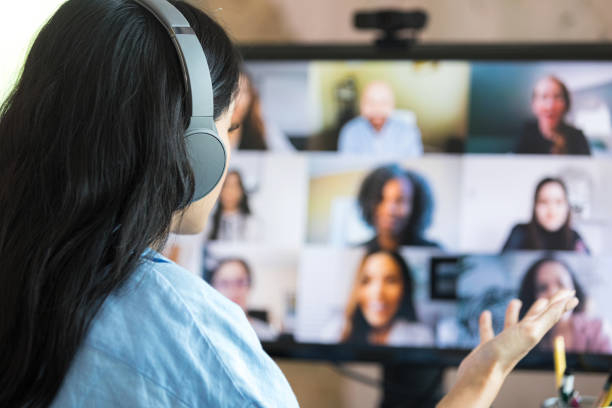
Photo via istockphoto.com -
Including your full name and pronouns in your profile is an important step toward creating an inclusive and respectful meeting environment. Most meeting software platforms provide the option to add your name to your profile, and some even have specific fields for pronouns.
Adding your full name helps meeting participants easily identify who you are. It allows others to address you correctly and avoids any confusion or miscommunication.
Including your pronouns in your profile helps others refer to you using the appropriate pronouns. Pronouns are an essential aspect of someone's identity, and using the correct pronouns demonstrates respect and inclusivity. By normalizing the practice of sharing pronouns, you create a more welcoming environment and encourage others to feel comfortable sharing their own pronouns.
When you state your full name clearly and slowly during meetings, especially in larger or unfamiliar settings, it helps ensure that everyone can hear and understand your name correctly. This allows others to address you accurately and avoids any potential mispronunciations or misunderstandings.

Photo via istockphoto.com 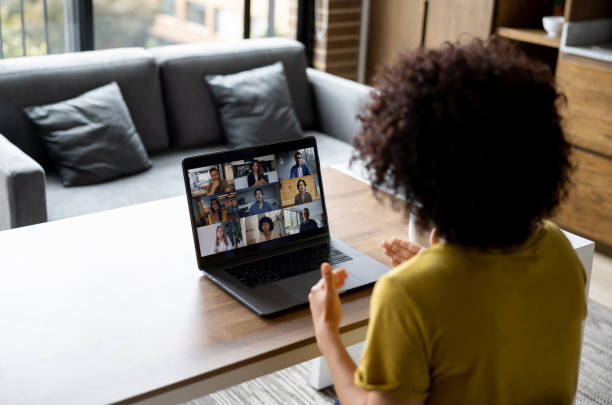
Photo via istockphoto.com -
Scheduling breaks during long meetings is a considerate and inclusive practice that benefits all participants, particularly those who may have specific needs or challenges.
Prolonged sitting can be uncomfortable and even painful for some individuals, including those with chronic pain or conditions that make sitting for long periods difficult. By scheduling breaks, you provide an opportunity for participants to stretch, move around, and alleviate any discomfort they may be experiencing. This promotes better physical well-being and reduces distractions caused by physical discomfort.
Long meetings can be mentally draining, and concentration levels may wane over time. By incorporating breaks, you allow participants to recharge and regain focus. This enhances overall engagement and productivity during the meeting.
Breaks are particularly important for individuals who are or were recently pregnant, as well as those with specific health conditions or mobility challenges. These individuals may require additional support and accommodations to ensure their comfort and ability to fully participate. By scheduling breaks, you create a more inclusive environment that acknowledges and accommodates diverse needs.

Photo by Alexander Suhorucov via pexels.com 
Photo by Alexander Suhorucov via pexels.com



































